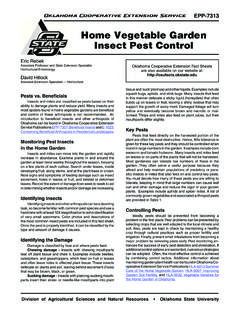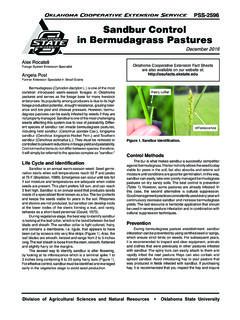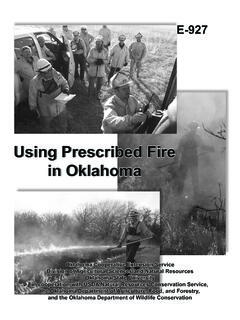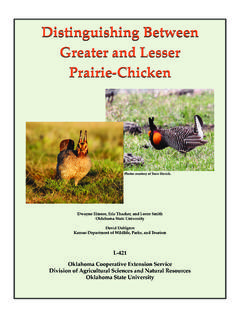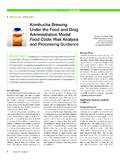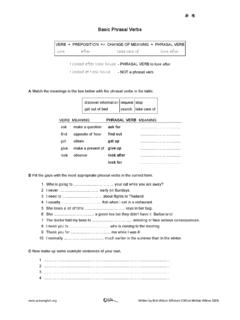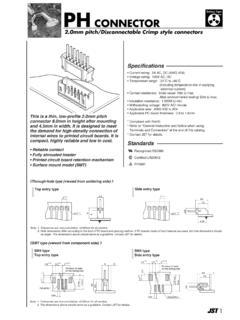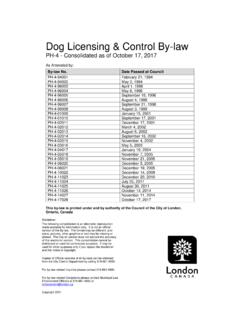Transcription of FOOD TECHNOLOGY FACT SHEET - DocuShare
1 FAPC-118. FAPC-118. Robert M. Kerr food & Agricultural Products Center food TECHNOLOGY fact SHEET . Adding Value to OKLAHOMA. 405-744-6071 The Importance of food pH in Commercial Canning Operations William McGlynn Extension Horticultural Foods Scientist Introduction why a low-pH food is a high-acid food and vice versa. The pH value of a food is a direct function of the free The range of pH is commonly considered to extend from hydrogen ions present in that food . Acids present in foods release zero to 14. A pH value of 7 is neutral, because pure water has a these hydrogen ions, which give acid foods their distinct sour pH value of exactly 7. Values less than 7 are considered acidic, flavor. Thus, pH may be defined as a measure of free acidity. while those greater than 7 are considered basic or alkaline. Figure More precisely, pH is defined as the negative log of the hydrogen 1, below, shows the approximate pH values of several types of ion concentration.
2 Foods. A more detailed list is given in Appendix 1. A few foods, Therefore, if a food has a pH value of 3, then the such as egg whites, sweet corn and some baked goods may be concentration of hydrogen ions present in that food is equal to 10-3 basic. Most foods are naturally acidic, with a pH value less than ( ) moles/liter. If the pH value is 6, then the concentration of Even so, the pH value of a particular food may have a hydrogen ions equals 10-6 ( ) moles/liter. dramatic effect on the type of processing needed to safely These examples show the concentration of hydrogen ions preserve it. decreases as the pH value of the food increases. This explains Oklahoma Cooperative Extension Service Division of Agricultural Sciences and Natural Resources pH and microbial growth The canning process must also be reviewed and certified Microorganisms, including yeasts, molds and bacteria are by a Recognized Process Authority.
3 A Recognized Process sensitive to a food 's pH. Very low or high pH values will prevent Authority is any person recognized to have the training, microbial growth. As a practical matter, no unprocessed food has experience and equipment needed to determine or verify the a pH value high enough to offer much preservative value. Many sufficiency of a thermal process. This person serves as an foods do have pH values low enough to offer some protection independent information resource for both the processor and against microbial growth. However, very few foods have pH regulatory agencies. Recognized Process Authorities may be values low enough to completely inhibit the growth of affiliated with private companies, universities or trade microorganisms, especially yeasts and molds, which can tolerate organizations. lower pH conditions than most bacteria.
4 For almost all foods, some combination of microbial controls, such as heat processing, Canning high-acid foods refrigerated or frozen storage, or drying must be used to help Examples of high-acid foods include jams and jellies, preserve the food . The most common of these is heat processing pickles and most fruits. Because there is no fear of Clostridium or canning. Canned foods may be defined as any food sold in a botulinum growth, these foods require much less heating than hermetically sealed (water and air-tight) container at non- low-acid foods. To be safe, such foods need only to reach refrigerated temperatures. pasteurization temperatures. For foods with a pH value of or Some of the most important pieces of information used in a less, 175 F ( C) is a sufficient pasteurization temperature. canning operation are processing times and temperatures.
5 To be Those foods with a pH range between and 4 have a clear, processing times do not, in this case, refer to the time recommended pasteurization temperature of 185 F (85 C). For needed to cook the food . Rather, processing times mean the foods with a pH range of 4 to , the recommended heating times needed for canned food products to reach what is pasteurization temperature rises to 195 F ( C). Foods with a known as commercial sterility. Commercial sterility may be pH value of to have a recommended pasteurization defined as the point when any harmful microorganisms capable of temperature of 210 F (99 C). growing in the food have been killed. The exact processing time These pasteurization temperatures are sufficient to kill all for a canned food product will depend on several factors. These microorganisms except for bacterial spores.
6 Since the spores will include the pH of the food , the thickness or viscosity of the not grow because of the low pH, the food is considered product, the size of the food particles, the dimensions of the commercially sterile. A high-acid food will therefore not need the container and the temperature of the cooking medium. For high-temperature process a low-acid food requires. A high-acid canning in particular, the pH of the food plays a key role in food may typically be processed in a hot water or steam bath at determining the extent of heat processing needed to insure a safe atmospheric pressures no pressure-cooking is required. final product. For this type of processing, the sealed container is heated in the bath until the internal temperature of the slowest heating point reaches the recommended pasteurization temperature for Canning low-acid foods two to10 minutes, depending on the pH value and other properties As seen in Figure 1, a low-acid food is defined as a food of the food .
7 The time required to reach this temperature will vary, having a pH of more than , while a high-acid food is defined as and is usually set by a Recognized Process Authority after a food with a pH value of or lower. This value is critical reviewing the food , evaluating the process and perhaps because of one particular bacterium, Clostridium botulinum, which conducting heat penetration tests. produces a dormant form called a spore. These spores are It is important not to over-fill the containers when a water or extremely hard to kill and may survive for many years, waiting for stream bath process is used in order to allow room for product a chance to grow. An improperly processed can of food provides expansion during processing. A headspace of at least one-fourth an ideal environment for Clostridium botulinum spores, since the of an inch (7 mm) is recommended between the lip of the bacteria cannot survive in the presence of oxygen.
8 Clostridium container and the surface of the food or brine. It is also important botulinum produces an extremely potent neurotoxin among the to make sure the containers are completely covered with water deadliest poisons known. Trace amounts of this toxin, which during the process to insure even heat penetration and avoid causes the food -borne illness known as botulism, are enough to under-processing. kill. Fortunately, the spores of Clostridium botulinum will not grow An alternative processing method is to heat the high-acid if the pH of a food is or less. For low-acid foods with a pH food product to pasteurization temperatures and fill it hot into jars value greater than , these spores must be killed by heating for sealing. This popular processing technique is known as hot- during the canning process. Because these spores are very heat filling or hot-fill/hold.
9 Hot-filling works well if done properly. It is resistant, canned low-acid foods must be pressure-cooked at high important to keep in mind the container must be sealed before the temperatures for long periods of time. Temperatures of 240 F food drops below the recommended pasteurization temperature. ( C) or greater are commonly used and process times may For this reason, it is a good practice to heat the food to five to 10. range from 20 minutes to several hours. Most vegetables, meat degrees above the recommended pasteurization temperature and poultry foods fall into the low-acid food category. Because of before filling. This allows time for filling and sealing. For example, the necessity of insuring the proper processing of low-acid foods, if the recommended pasteurization temperature for the product is there are a number of detailed regulations governing their 185 F (85 C), then the product should be heated to approximately production.
10 Anyone wishing to can low-acid foods must be 195 F ( C) prior to filling. registered with the FDA, use certified equipment, have received Keep in mind with a hot-fill process the inner surfaces of proper training at a Better Process Control School and keep the jar, jar neck and cap must also reach pasteurization extensive records as specified by federal regulations (21 CFR Part temperatures in order to kill any microorganisms present on these 113 for FDA-regulated foods and 9 CFR Part 318 for USDA- surfaces. One good way to insure this is to turn each container regulated foods). upside down and hold it for least two minutes after filling and 118-2. allows the hot product to sterilize the inner jar caught, the result can be a deadly case of botulism. surfaces. After this hold period, the jars may be cooled if desired. For these reasons, producers of acidified foods must Note hot-filling may not work for large particulate products register their formula and processing procedures with the FDA, such as pickled whole cucumbers or beets, in which the pieces just as canners of low-acid foods do.



